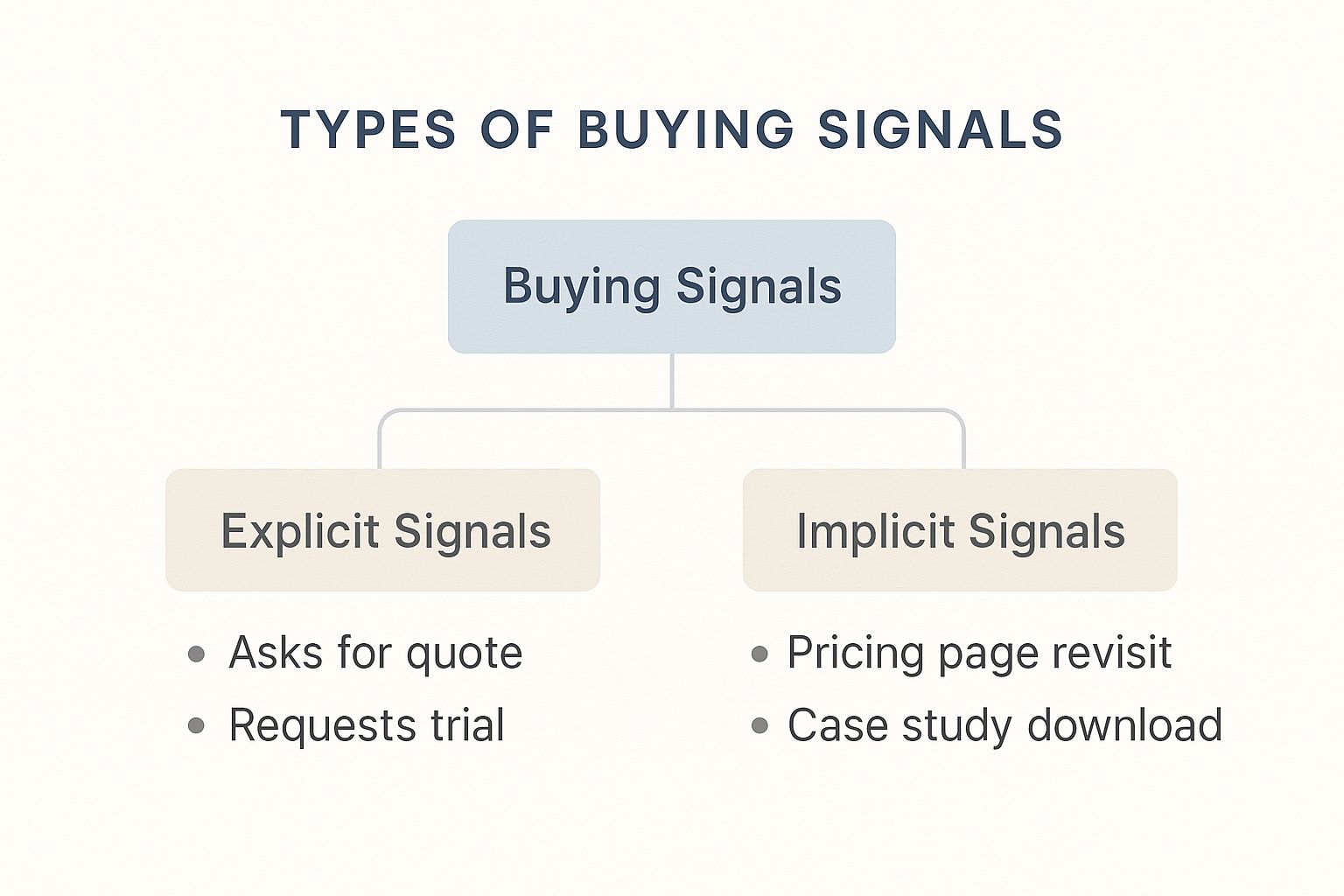What Is a Buying Signal? Key Tips to Identify Them Quickly
Discover what is a buying signal and learn how to recognize verbal and digital cues in B2B sales to close deals faster and boost your pipeline.
Discover what is a buying signal in sales with our guide. Learn to spot verbal and digital cues to qualify leads and close deals faster.
TL;DR: A buying signal is a clear cue from a prospect—like asking for a demo or repeatedly visiting your pricing page—that they're moving from browsing to buying. Spotting these signals lets your sales team ditch the cold calls and focus on warm, high-intent leads, dramatically boosting efficiency and win rates.
So, what exactly is a buying signal? Think of it as a clue a potential customer leaves behind that says, "Hey, I'm getting interested." These are the small actions and behaviors that show someone is moving from just browsing to seriously considering a purchase.
Spotting these cues—like someone asking for a demo or repeatedly visiting your pricing page—is absolutely critical. They're the breadcrumbs that lead you straight to your most promising deals.
Think of your sales process like a detective story. Buying signals are the fingerprints your prospect leaves at the scene. When you learn to spot them, you can stop chasing dead ends and focus all your energy on the leads that are actually ready to talk. The result? Better efficiency and, more importantly, higher win rates.
Of course, before you can find any clues, you need a pipeline full of suspects. Learning a few effective LinkedIn lead generation strategies is a great way to fill that pipeline, giving you more chances to spot those crucial buying signals and tailor your follow-up with perfect timing.

Ever played poker? A buying signal is the sales equivalent of a "tell." It’s that subtle shift in behavior—an action, a question, a download—that shows a prospect is moving from just browsing to seriously considering a purchase. It’s the difference between someone just kicking the tires and someone asking for the keys to take a test drive.
This is the absolute core of signal-based selling. It’s about timing your outreach to the precise moment a prospect’s intent becomes clear.
The way we spot these signals has completely changed. Back in the day, a firm handshake, direct eye contact, and pointed questions across a desk were the gold standards. Today, the most valuable clues are often digital breadcrumbs left across the internet long before you ever get on a call.
This shift is everything. Buyers now do a massive chunk of their research on their own. We’re talking up to 80% of their decision-making process is over before they even think about contacting a sales rep. The signals have simply moved online, and we need to move with them.
A buying signal isn’t just a random click or a casual question. It's a piece of evidence that a prospect is actively moving down the path to purchase, signaling a window of opportunity for sales teams to engage with relevance and precision.
In the old model, the sales conversation was the start of the journey. Now, it's often just a final checkpoint. Prospects show up to the conversation armed with information, having already read reviews, compared vendors, and formed strong opinions.
All that self-directed research creates a trail of digital signals. These actions are a form of intent data, giving you a powerful glimpse into what a prospect is thinking and what problems they're trying to solve. For a deeper dive, check out our guide on what is intent data.
By paying close attention to these digital cues, you can completely change your game:
Ultimately, learning to read both the old-school signals and the new digital ones transforms your sales approach from reactive to proactive. You're no longer waiting for the phone to ring; you're joining the conversation exactly when it matters most.
Not all buying signals are created equal. Some are loud and clear, while others are subtle whispers you have to lean in to hear. Understanding the difference is mission-critical for timing your outreach and making it count.
Think of it like this: signals fall into two main camps. One group is like a prospect shouting their intentions from a rooftop—you can’t miss it. The other is more like a trail of digital breadcrumbs they leave behind. Learning to recognize both is what separates the good sales reps from the great ones.
This infographic breaks down the hierarchy of buying signals into these two core types.

As you can see, explicit signals are direct asks, while implicit signals are all about behavior and require a bit more interpretation.
Explicit signals are the most obvious, high-intent actions a prospect can take. There’s no ambiguity here. They are actively raising their hand, asking for more information, and driving the sales conversation forward themselves. When you see one of these, it’s a clear green light.
These are the strongest indicators of purchase intent because they require a real effort from the prospect. They are volunteering their time and signaling they’ve moved past casual research into active evaluation.
Here are some of the most common examples:
Implicit buying signals are the behavioral breadcrumbs prospects leave behind as they do their homework. They’re more subtle than explicit signals but are incredibly valuable for figuring out who is getting more and more engaged. These actions show interest and growing consideration.
While a single implicit signal might not mean much, a cluster of them is a powerful indicator of rising intent. For example, someone visiting your pricing page once could just be a competitor snooping around. But a prospect who visits three times, downloads a related case study, and attends a webinar? That’s someone your team needs to contact. Immediately.
Think of implicit signals as puzzle pieces. One piece doesn't reveal much, but as you collect more, a clear picture of the prospect's intent begins to form.
Common implicit buying signals include:
To really nail this down, it helps to see both types of signals side-by-side. Each one tells you something different about where the buyer is in their journey.
| Signal Type | Definition | Example Action |
|---|---|---|
| Explicit | Direct, unambiguous actions where the prospect clearly states their interest. | Prospect fills out your "Request a Demo" form after reading a blog post. |
| Implicit | Indirect, behavioral clues that suggest growing interest and require interpretation. | Prospect visits your pricing page three times in one week and downloads a case study. |
Ultimately, mastering both types of signals is key. Explicit signals tell you who is ready to talk right now, while implicit signals help you build a pipeline of future-ready prospects and engage them before your competitors even know they exist.
Moving from what a buying signal is to why it matters is where the real magic happens. This isn't just another sales tactic to add to the playbook; it's a fundamental shift in how you find and engage customers. It's about transforming how you spend your most valuable resources: your time and your team's energy.
Instead of casting a wide, inefficient net and hoping for the best, you zero in on the small fraction of prospects who are actually ready to talk. The whole idea is simple but powerful: stop chasing cold leads and start joining conversations that are already happening. This lets your team operate with surgical precision, engaging buyers right at the peak of their interest.
Focusing on buying signals isn't just a feel-good strategy—it delivers concrete, measurable results that show up on the bottom line. It’s the classic case of working smarter, not harder, by aligning every bit of sales effort with genuine buyer intent.
Think about it this way: at any given moment, only about 5% of your target market is actively looking for a new solution. If you're ignoring the signals, you’re almost certainly wasting your time on the other 95%.
The data backs this up. Organizations that get this right see a 10% to 20% bump in new opportunities and manage to slash their customer acquisition costs by up to 30%. Even better, these companies report 40% to 50% higher win rates just by focusing on prospects who are already raising their hands.
By zeroing in on prospects who show clear intent, sales teams can dramatically shorten sales cycles. You spend less time convincing and more time closing, which is the ultimate goal.
Relying on guesswork and pure volume is a recipe for a volatile sales pipeline, full of unpredictable peaks and valleys. A signal-based strategy, on the other hand, brings a much-needed layer of predictability into the mix.
When you consistently track and act on buying cues, you create a steady flow of truly qualified opportunities moving through your B2B sales funnel.
This shift doesn't just empower individual reps; it elevates the entire revenue team. Sales leaders get a clearer view of pipeline health and can forecast with way more accuracy. Marketing teams can fine-tune their campaigns based on which signals produce the highest-quality leads. It creates a smart feedback loop where every part of your go-to-market engine gets sharper and more aligned.
Ultimately, mastering what a buying signal is in sales gives you a massive competitive advantage. You stop interrupting prospects and start showing up to help at the exact moment they need you most, building stronger relationships and driving sustainable growth.

Knowing what buying signals are is one thing. Actually turning that knowledge into a repeatable process that drives revenue is a completely different ballgame.
To consistently catch these cues, you need a smart blend of technology and sharp human intuition. It’s not just about spotting signals—it’s about building a system that tells you exactly what to do when one pops up.
The first step is setting up your digital listening posts. Think of your existing tools, like your CRM and website analytics, as goldmines of implicit signals. By tracking who’s repeatedly visiting your high-value pages or spending serious time with your content, you can see interest heating up in real time.
This isn't just theory. It's the practical foundation for mastering signal detection.
Most modern buying signals show up in a company’s digital footprint. The best place to start is with the digital properties you already own and control. You don’t need a bunch of fancy new tools to get going; you just need to know where to look.
Here’s a simple framework to get started:
By setting up this basic tracking, you’re essentially creating an early-warning system that flags prospects right as their interest spikes.
While digital signals are incredibly powerful, the clues dropped during a live conversation are just as critical. Active listening isn’t just about hearing what someone says; it’s about understanding the intent behind their words. Sales reps who get this right can uncover buying signals that technology would completely miss.
Pay close attention to questions that shift from "what if" to "how to." For instance, when a prospect asks, "What are the next steps for implementation?" or "Who on my team would need to be involved in onboarding?" they’re no longer just kicking the tires. They're mentally picturing a future with your product.
When a prospect starts using words like "we" and "our" while talking about their challenges in the context of your solution, they’re starting to see you as a partner, not just another vendor. This subtle language shift is a huge verbal buying signal.
This is where the combination of tech and human skill becomes so powerful. High-intent activities, like requesting a demo or revisiting the pricing page for the third time, signal a mental shift from ‘if we should buy’ to ‘how we will buy.’
Prioritizing these real-time cues—a strategy known as signal-based selling—has been shown to dramatically improve both pipeline predictability and conversion rates.
Spotting a signal is only half the battle. Your response has to be fast, relevant, and genuinely helpful. A generic "just checking in" email completely squanders the opportunity.
Instead, create a simple ‘if this, then that’ playbook for your team. This kind of consistency is a cornerstone of effective sales process automation and ensures no signal goes to waste.
If a prospect downloads a case study about your Salesforce integration...
Then send a personalized email mentioning their interest and offer a quick, 15-minute call to discuss how other companies in their industry found success with that exact integration.
If a prospect revisits your pricing page three times in one week...
Then reach out with a helpful note, offering to clarify the different tiers to make sure they’re looking at the best package for their needs.
This targeted approach shows you’re paying attention and adds real value, turning a simple digital signal into a meaningful sales conversation.

Let's be real. Manually tracking every digital footprint, verbal hint, and behavioral shift across all your target accounts is completely impossible. The sheer volume of information would bury even the most organized sales team.
This is exactly where modern tools, especially those running on AI, come in. They act as a force multiplier, connecting the dots you'd otherwise miss.
These platforms are designed to pull together and analyze data from dozens of different places—your CRM, website analytics, marketing tools, and even public sources like job postings and press releases—to find meaningful patterns. This isn't about replacing sales reps. It's about giving them a ridiculously smart assistant that does all the heavy data lifting.
AI-powered platforms can automatically surface high-intent accounts that would otherwise stay hidden in the noise. They go beyond simple tracking to give you predictive insights, helping you focus your energy where it’ll actually make a difference.
Here’s where they really shine:
Think of these tools as your 24/7 research team. While you're busy building relationships and closing deals, the technology is constantly scanning the horizon for the next big opportunity. You never miss a critical signal.
This automated approach is the core of what’s known as signal-based selling. If you want a complete breakdown of the strategy, you can learn more about signal-based selling in our detailed guide.
The real magic of these tools is their ability to turn scattered data points into a clear story. For example, a platform like Salesmotion doesn't just tell you an account is hiring. It digs into the job description to identify strategic priorities you can tie your pitch directly to.
This level of analysis frees up reps to do what they do best: sell. By automating the research, you empower your team to walk into every conversation armed with relevant, timely, and impactful information.
For a deeper look at the technology behind this, check out these 5 Ways AI Identifies Purchase Intent. It’s a great resource for understanding how these platforms pinpoint when a customer is ready to buy.
Still have a few questions rattling around? Perfect. Let's tackle the most common ones to make sure these concepts are crystal clear.
This is a great question because it gets to the heart of why signals matter so much. A lead is basically anyone who might fit your ideal customer profile. They're on the list, a potential match, but that's about it.
A buying signal, on the other hand, is an action. It's a specific behavior that tells you a lead is actively thinking about making a purchase right now.
Think of it this way: everyone who walks into a car dealership is a lead. But the person who pops the hood, asks for the keys, and says, "Can I take this one for a test drive?"—that person is giving off a strong buying signal. One is a possibility; the other is clear intent.
Absolutely, and it's a trap many reps fall into. A single, isolated action can easily be misinterpreted. For example, a competitor’s employee poking around your pricing page is technically a signal, but it’s not coming from a place of genuine buying intent.
Context is everything. The real magic happens when you spot clusters of signals. A pricing page visit combined with a case study download and a sudden spike in email opens? Now you've got a story. That's how you confirm a prospect is truly in-market and not just kicking tires.
For high-intent signals—like someone filling out your "Request a Demo" form—the answer is: immediately. Speed is everything in these moments. All the research points to the same conclusion: your odds of actually connecting with a lead plummet after the first five minutes.
When you get one of these explicit signals, you need to be on it. The prospect's interest is at its absolute peak in that moment. A fast, relevant response dramatically increases your chances of starting a real conversation and actually moving the deal forward. Waiting even an hour can be the difference between a closed-won deal and a ghosted opportunity.
The strongest signals are explicit actions like requesting a demo, asking for a quote, or inquiring about specific integrations. Common implicit signals include repeatedly visiting your pricing page, downloading a case study, or a key decision-maker attending one of your webinars.
Start by using your existing tools. Set up alerts in your website analytics for repeat visits to high-value pages (like pricing or features). Use your CRM to track engagement spikes, and monitor who downloads high-intent content like whitepapers or case studies.
It depends on the signal's strength. An explicit signal like a "Request a Demo" form is a clear green light to act immediately. For implicit signals (like a single page visit), it's better to wait for a cluster of actions to confirm genuine intent before reaching out.
Stop wasting hours on manual research and start acting on real-time account intelligence. Salesmotion automatically surfaces critical buying signals and generates the insights you need to engage high-value accounts with precision. Discover how Salesmotion can transform your sales process.
Discover what is a buying signal and learn how to recognize verbal and digital cues in B2B sales to close deals faster and boost your pipeline.
Learn how B2B data enrichment transforms raw contacts into valuable insights. Discover strategies and tools to enhance your sales and marketing...
Discover how a B2B sales intelligence platform transforms your sales process. Learn to choose the right tool to find leads and close deals faster.